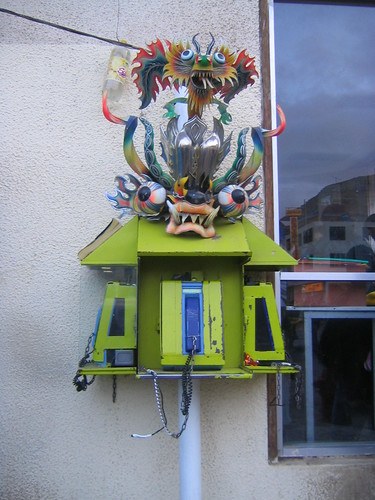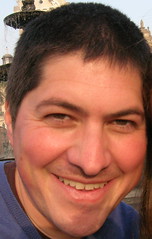4.28.2006
Iglesia de La Ermita

La Iglesia de La Ermita, Barranco, Lima. Photo by Roddy Scheer.
If you've ever wandered through the quaint Lima district of Barranco, filled with decaying (and increasingly restored!) Republican mansions, then you've probably seen this church. It's to your right as you stand on the Puente de los Suspiros (Bridge of Sighs), looking down toward the ocean.
I've only ever known this church as the place where my mother was baptized. What she was doing in Barranco as an infant I don't know, since she grew up poor in Barrios Altos. Unless this was before my scoundrel grandfather left my abuelita and her eight kids. He was a man of means, so the family might have been doing well and living among the "buena gente" at that point in time. (All fodder for a future posting!)
When I first saw it in the late 80s, La Ermita was looking her age. She wore a fading coat of pink. Numerous holes in the roof eposed the cane wattle beneath. I would have guessed that she was slated for demolition, or at least terminal neglect.
But, I'm happy to see that she's been restored. And with a little digging, I found out that there's a mythical story attached to the church.
"Legend has it that many years ago, a group of fishermen were lost in Lima's winter sea mist for several hours. After praying and searching in the dense darkness, they saw a bright, glittering light in the distance. They rowed towards it and were saved. Once on land, they looked for the place where they had seen the light and found a cross. La Ermita was built on that spot."This story comes from the August 2005 newsletter of ACAP - The American and Canadian Association of Peru.
Tags: La Iglesia de la Ermita, Barranco, Lima, Peru, Republican mansions, Puente de los Suspiros, Bridge of Sighs, Barrios Altos, ACAP, American and Canadian Association of Peru
The joys of planning a trip

La Reyna Sophia in her native environment.
Creating a travel itinerary is half the fun: looking through travel books, poring over maps, hunting for obscure destinations. But it's even more fun when you know that you're going to have a guest in tow and you want to be sure to create memorable expriences for her.
So, on with the photo itinerary...
So far, I'm thinking that we'll first spend some time in Lima, where we'll no doubt be stuffed silly by my aunts, uncles and cousins with delectibles like Arroz Chaufa, Aji de Gallina, Papas a la Huancaina, sopas and ceviche. Of course food will be an issue with Miss Picky, but it's nothing a jar of peanut butter and locally baked bread won't cure. And since most Peruvians don't consider a meal proper unless it involves rice, or potatoes, or both (is that the sound of Dr. Atkins turning in his grave?), we should be in good shape.

The Lima of tourist brochures. Photo by Irish Guy.
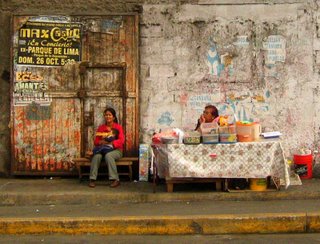
Lima for real. Photo by Phil Douglis.
After time in Lima, we'll take the central railroad to Huancayo (world's highest standard gauge railroad: see previous post), and then bus it to Ayacucho, Andahuaylas, Abancay and Cusco, in time for the Inti Raymi festival and the general festive chaos that is Cusco in late June.
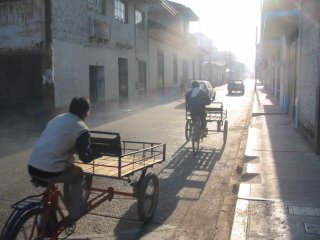
Market day in Huancayo. Photo by Irish Guy.

All those reports on that bus plunge site are made up...aren't they? Photo by Cécile Obertop
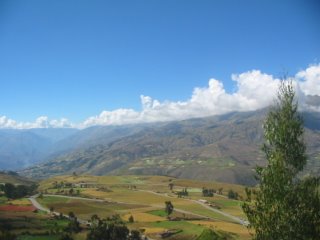
The beauty of the Ayacucho region. Photo by Irish Guy.
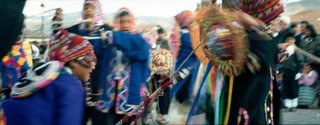
Merriment in Cusco. Photo by Don Ball.
I've never stayed in Cusco for the actual festival. My reluctance begins with the bitter fact that one has to trek up to Sacsayhuaman at 5 a.m. to get a decent viewing spot.
More importantly, there's no better time to be at Machu Picchu. On June 24, Winter Solstice, the sun will rise and shine through a niche in a far-off mountain (see below) and begins casting shadows in pre-determined spots on rocks, walls, etc.
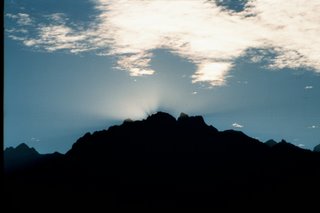
Only drawback: June is dry season in the mountains, so the hills look rather scrubby. Compare these two pictures and you'll see what I mean.

Sacred Valley (near Cusco) in the dry season.
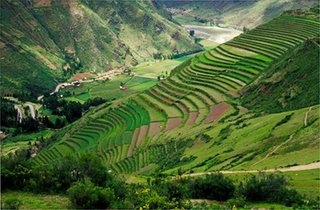
Sacred Valley in rainy season.
Tags: Peru, Lima, Arroz Chaufa, Aji de Gallina, Papas a la Huancaina, sopas, ceviche, train, huancayo, Ayacucho, Andahuaylas, Abancay, Cusco, Inti Raymi, Sacsayhuaman, Machu Picchu, Winter Solstice, Sacred Valley, Valle Sagrado
4.18.2006
I've died and gone to Lima
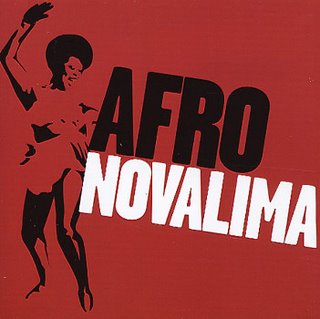
I just discovered this album, "Afro" by Novalima (thank you, KCRW), and had to download it immediately. I'm in heaven listening to these cuts, which are a modern, downtempo take on some Afro-Peruvian classics. According to their website, Novalima is a "production collective created in 2001 by four Peruvian musicians based in Hong Kong, London, Barcelona and Lima."
If you remember the album of Afro-Peruvian music David Byrne put out in the mid 90's, you'll certainly recognize the base sound and maybe even some of the specific tunes on "Afro." This album departs from the traditional sound by adding some salsa, son and cancion criolla to the mix, and then leavening the tracks with a heaping dose of new-skool samples, beats and synth riffs.
I still have lots more listening to go, but if you like other fusion artists like Sidestepper, Bossacucanova and Gotan Project, this is a disc you should probably check out.
Tags: Novalima, Afro, cancion afroperuana, KCRW, David Byrne, Sidestepper, Bossacucanova, Gotan Project
4.17.2006
El Central rides again

Ferrovias Central Andino chugs to an altitude of 16,640 feet. Photo courtesy of the Kells Transport Museum Website.
The world's highest railway reopened for service on April 13. Only $50 for a round-trip ticket from Lima to Huancayo. See my previous post for more pictures.
Tags: Train, Ferrovias Central Andino, Lima, Huancayo
Holy week in Guatemala

A holy week procession, complete with an "alfombra," or rug, usually made of flower petals or colored sand.
Gringoperdido is a blogger at Anthropology.net who lives in Guatemala and made these observations of the country's lead-up to Easter:
This whole week is rife with pagany goodness throughout the Christian world. In the US and Western Europe, the strange fascination with bunnies and eggs predates Christianity, while here in Mayaland, the idea of sacrifice transcends time (so does resurrection, incidentally, but sacrifice is a biggie). [snip]I looked up this Maximon character (I always find the dark saints and deities more interesting) and found a description of him at Lucky Mojo.com:
In several of the bigger Maya communities, there are wonderfully ideosyncratic variations of traditonal Catholic ceremonies. On the shores of Lake Atitlan, for example, one village has 2 processions--one for Jesus and another for Maximon, a local "dark saint" who, depending on who you talk with, is a version of Satan, Judas, or one of several Precolumbian gods. But all agree that he really likes alcohol, cigarettes, and his various shrines are visited a lot by prostitutes, drug traffickers, and others from the fringe of society. When the two processions meet, there's apparently a mock battle between the two groups (which I believe Jesus wins).
The "man in black" seen on many Guatemalan folk charms is Maximon (pronounced "Mashimon"), a local deity also know as Hermano San Simon, "Brother Saint Simon Peter." Maximon is actually a pre-Columbian Mayan god of the underworld formerly known as Maam ("grandfather"); his modern name is a conflation of Maam and Simon. Contemporary images do not depict the deity himself, but rather a life-sized carved wooden statue of the god dressed in 20th century clothing. He is portrayed as a mustached man seated outdoors at a crossroads, wearing a black suit, red tie, and wide-brimmed hat.Finally, here's a votive image of the man himself. The grandfather of Mayan deities. Or, perhaps Godfather would be more appropriate...

A saint with a deal you can't refuse: "Maximon", a.k.a. "Hermano San Simon", a.k.a. " Maam."
Tags: Easter, Holy Week, Guatemala, procession, alfombra, Christianity, Maya, sacrifice, Catholic, Catholocism, ceremonies, Lake Atitlan, Jesus, Maximon, Precolombian, alcohol, cigarettes, Hermano San Simon, Maam
4.14.2006
Direct line to the gods
The politics of coca

As you munch your poppyseed muffin, consider how absurd it might seem if suddenly the United Nations were to declare your muffin illegal.
Something similar happened in the late 1940s on the coca front. Despite more than a millenium of legitimate use by the people of the Andes, the crop was criminalized by the U.N.
Recently elected Bolivian President Evo Morales, himself once a radical defender of coca farmers' rights, wants to see that changed. By de-criminalizing coca he hopes to clear the way to develop overseas markets for legitimate, coca-based products, such as soaps, toothpaste, food products and more.
Get the full story from Juan Forero, the New York Times' man in South America, in a brilliant video report.
Tags: United Nations, coca, Andes, Bolivia, Evo Morales, coca farmers, coca eradication, Juan Forero, New York Times
4.03.2006
The aerial splendor of Mexico City

Are they new housing projects or a Hollywood CGI backdrop?

The "floating gardens" of Xochimilco, shrouded in morning mist.

They can't buy you happiness, but millions of pesos will get you your own spot in the sun.

Possibly the first aerial photo ever of a minibus-crypt collision.

This one just might be my favorite. Surrounded by the sprawl of the Chalco neighborhood, farmers work the interior of Xico crater as they probably have for centuries.
Tags: Mexico, Mexico City, D.F., distrito federal, aerial photography, aerial photos, helicopter pilot, C.O. Ruiz, Xochimilco, Bosque de Las Lomas, cemetery, Chalco, Xico crater
4.02.2006
Real estate roundup
A front-row seat at the next labor protest

Dig the view from this apartment overlooking Lima's Plaza de Armas, the Cathedral of Lima and one side of the Presidential palace. Watch from your living room window when they break out the armored cars with water cannons, affectionately known as "Pinochitos." No, to be fair, central Lima is an amazing place and this apartment is in the heart of it. (Incidentally, my great grandfather was a presidential guard when one of the presidents of Peru was killed in a coup d'etat. Same location, but it was a different palace building at the time.)
Relive the plunder of ancient Peru...in your own colonial mansion

I find Spanish colonial architecture fascinating. Typically, you can't tell much about the house from the street. If you've strolled the French Quarter in NOLA (which is actually mostly Spanish), you've seen what I mean. Especially if you happened to peer through an open door, down a narrow hallway and into the glorious sunlit courtyard inside. That's by design -- you're simply not meant to know what goes on inside, unless you're invited in. Even then, you don't see everything upon walking through the front gate. There might be a second threshhold, after which you enter the inner sanctum of the household -- the courtyard. Even then, you'll need to enter a formal Salon de Espera or reception room and present yourself. Ah the good ol days. Anyway, this mansion, though well worn, is a beaut...and yours for only $500k and change. Ghosts thrown in free of charge.
Your own private Inca empire

Running a bed and breakfast means getting up at godawful hours and making breakfast for other people. Or does it? In Peru, with its dearth of underemployed laborers, you could hire cooks and housekeepers at a reasonable rate (and give some folks a decent living at the same time), which would leave you to socialize like a haughty English colonizer in a Kipling novel. Ok, maybe not. But, you certainly would be free to run expeditions and tours to some of the most amazing ruins and mountain country in the hemisphere. And this would be your home base: a 16-bed inn in the town of Urubamba, called Hospedaje Macha Wasi. Urubabma is in the Sacred Valley of the Incas, along the main tourist route. Problem is, it's not a major destination unto itself. There are no great ruins, like at Pisaq or Ollantaytambo. So, filling the beds here would require a different strategy. Mountain bike tours? Horseback tours? Catering to Chinese and Taiwanese tourists? Nothing that some good marketing and networking couldn't overcome. So, any would-be investors out there?
BTW, the most amazing thing about the Sacred Valley is what grows there. The sun is equatorial and it stays in the 70s all year long. At this inn, they've got orange, capuli (native to the Andes), plum (3 or 4 varieties), pear, apple and avocado trees, not to mention passionfruit vines!
Tags: Real estate, Peru, Lima, Plaza de Armas, Cathedral of Lima, Catedral de Lima, Presidential palace, Palacio nacional, colonial architecture, spanish colonial architecture, New Orleans, NOLA, French Quarter, assassination, bed and breakfast, kipling, Urubamba, Hospedaje Macha Wasi, Pisac, Pisaq, Ollantaytambo, Sacred Valley, valle sagrado
Resurrection
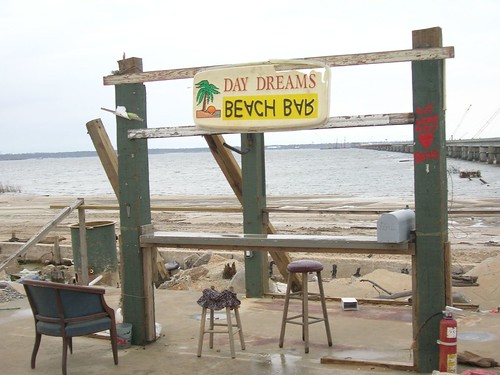
Ruins of the Day Dreams Beach Bar, Bay St. Louis, Mississippi. Photo by Don Ball
Looking for a photo to post that relates to my post-K activities, I found this one from a trip a few weeks ago to Bay St. Louis. Figuring that there must be a story behind this, I found the following exerpt from an article by Ace Atkin in Outside magazine.
Tags: Hurricane Katrina, Bay St. Louis, Mississippi, New Orleans, Mission from Minnesota, relief work, Outside magazine, Day Dreams Beach Bar, Ace AtkinDAYS BEFORE, we'd been in Bay St. Louis, Mississippi, which was a hollowed-out shell, roads collapsed on top of eroded shoreline, railroad tracks stretched and turned on the horizon like taffy. More than anywhere else, people came here to stand at the end of the little town—once populated by quaint restaurants and cafés, bars and bookshops—to look at the oddity of destruction.
On the edge of the beach, Jimmy Bodden asked if we'd like to join him at the bar he managed. For a few moments I thought Jimmy had gone a little nutty.
The bar?
Jimmy walked us down to the edge of the beach, where two support beams still stood. Todd Key, the bartender, searched for a two-by-four to nail across the beams. Todd laid out liquor bottles and even found the sign for the place, Day Dreams, in the wreckage.
Someone brought out a battery-powered radio. They played oldies for Jimmy. Beer was poured and the sun set over the Gulf. Everyone toasted the bar's owner, Ernie, a former marine who'd had his leg nearly blown off in Vietnam and had driven a United cab in New Orleans for 20 years to buy the place.
"Hey," said Rick Barbera, a regular, to anyone who joined the party. "There was a hurricane here, unless you didn't know."
They were still drinking, laughing, and listening to oldies when we left.

